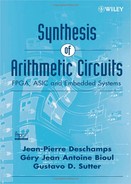3
NUMBER REPRESENTATION
Arithmetic deals with operations on numbers: addition, subtraction, and so on. Thus number representation is a fundamental topic in arithmetic ([ERC2004], [PAR1999]). The choice of a number representation system has repercussions on the complexity of the algorithms executing the arithmetic operations, and thus on the costs and performances of the circuits that implement those algorithms. Apart from the cost and performance, another aspect to take into account, when choosing a number representation system, is the interface with other circuits or, simply, the human interface. Consider an example: the residue number system (RNS) allows the implementation of very fast and cost-effective arithmetic circuits. Nevertheless, the RNS needs some type of relatively expensive input and output interfaces since human beings don't use it, and the AD/DA converters don't understand this type of representation. Thus the use of a RNS is limited to cases in which the extra cost of the RNS encoding and decoding is negligible with respect to the total cost. In this chapter the most common number representation systems are described. The chapter is divided into three sections corresponding to natural numbers, integers, and real numbers.
